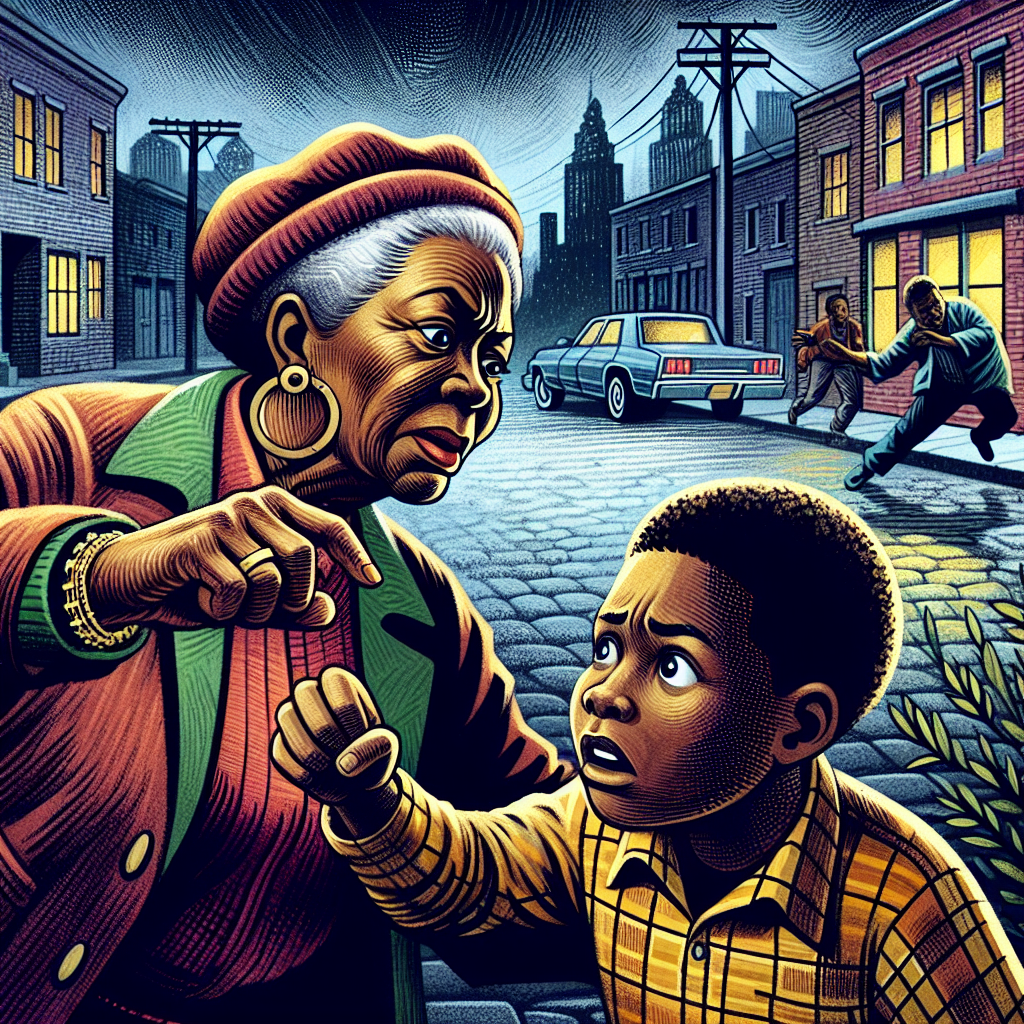-
目录
"探索善良与救赎:通过摘要、主题和人物深入探究《谢谢你,女士》"。
"谢谢您,夫人》是兰斯顿-休斯的一篇短篇小说,探讨了同情、救赎和善良的影响等主题。故事讲述了一个名叫罗杰的小男孩试图偷一个女人的钱包,却被卢拉-贝茨-华盛顿-琼斯夫人抓住。她没有惩罚他,而是把他带到自己家里,给他提供食物和指导。这个故事突出了同情和理解的力量,说明了一个善举如何改变一个人的一生。关键主题包括信任的重要性、人际关系的复杂性以及个人成长的潜力。故事中的人物,尤其是琼斯夫人和罗杰,通过他们之间的互动体现了这些主题,展示了当一个人受到同情而不是评判时,他改变的潜力。
谢谢您,女士》摘要
"兰斯顿-休斯(Langston Hughes)的短篇小说《谢谢您,夫人》(Thank You, Ma'am)以引人入胜的叙述方式探讨了同情、信任和复杂的人际关系等主题。故事围绕着一个名叫罗杰的小男孩和一位名叫卢埃拉-贝茨-华盛顿-琼斯夫人之间的一次偶遇展开。罗杰在绝望中试图偷走琼斯夫人的钱包。然而,琼斯夫人并没有做出愤怒或恐惧的反应,而是以意想不到的善意和理解做出了回应。
故事一开始,罗杰试图抢走琼斯夫人的钱包,结果却被她当场抓住。琼斯夫人当场抓住了他,她没有报警或严厉斥责他,而是选择带他回家。这一关键时刻为两个角色的转变经历奠定了基础。琼斯夫人是一个高大威猛的女人,体现了力量和韧性,而罗杰则是一个脆弱而误入歧途的年轻人,代表了许多与他处境相同的人所面临的挣扎。随着琼斯夫人表现出帮助而非惩罚的意愿,他们之间最初的紧张关系逐渐消散。
在两人相处的过程中,琼斯夫人与罗杰进行了交谈,透露了自己的人生经历和所面临的困境。这段对话使两个人物都变得人性化,让罗杰看到琼斯夫人不仅仅是一个受害者,而是一个有自己故事的人。在他们共进晚餐时,琼斯夫人传授了关于信任和尊重的宝贵经验,强调了做出更好选择的重要性。这种温馨的环境给罗杰带来了安全感,他开始反思自己的行为和铤而走险偷窃背后的原因。
故事的高潮出现在琼斯夫人给罗杰钱买他想要的蓝色绒面革皮鞋时,这一举动体现了慷慨和救赎的主题。这一善举不仅仅是为了钱,它还象征着琼斯夫人相信罗杰有改变的潜力。她以尊严和尊重对待罗杰,向他灌输了一种他可能一直缺乏的自我价值感。这一刻至关重要,因为它标志着罗杰人生的转折点,促使他重新考虑自己的选择和人生道路。
故事结束时,罗杰带着新发现的希望和决心离开了琼斯夫人的家。故事的结尾模棱两可,让读者思考琼斯夫人的善举对罗杰未来的持久影响。同情和理解的主题在整个故事中引起共鸣,说明了一个善举如何改变一个年轻人的人生轨迹。通过这种方式,休斯巧妙地捕捉到了人与人之间联系的本质,证明了同理心可以弥合不同世界之间的鸿沟。
总之,《谢谢您,夫人》是对两个背景迥异的人之间的动态关系的深刻探讨。休斯通过琼斯夫人和罗杰这两个人物,强调了同情的力量和救赎的潜力。这个故事提醒人们,理解和善意可以带来转变性的体验,最终塑造我们所遇到的人的生活。
谢谢你,女士》主要主题分析
在兰斯顿-休斯的短篇小说《谢谢您,夫人》中,出现了几个主要的主题,反映了人际关系的复杂性、善良的影响以及信任的改变力量。故事的核心是 "同情 "这一主题,通过两个主要人物卢埃拉-贝茨-华盛顿-琼斯夫人和小男孩罗杰之间的互动生动地诠释了这一主题。当罗杰试图偷琼斯夫人的钱包时,她没有选择愤怒或惩罚,而是选择了理解和同情。这一关键时刻为深入探讨同情心如何改变一个人的生活轨迹奠定了基础。
此外,"救赎 "这一主题也与故事的结构密不可分。罗杰最初被描绘成一个受绝望驱使的误入歧途的青年,但他发现自己所处的环境挑战了他对权威和信任的固有观念。琼斯夫人决定带他回家,给他食物,并与他交谈,这成为罗杰自我反省的催化剂。通过她的行动,罗杰获得了一次救赎的机会,这表明,即使是那些偏离了正确道路的人,也可以通过一个充满爱心的人物的影响,找到自己的归途。这一主题与 "每个人都有能力改变 "这一理念产生了共鸣,有时只需要一个善意的举动,就能激发人们转变观念。
谢谢您,夫人》的另一个重要主题是个人责任的重要性。在整个故事中,琼斯夫人都在强调罗杰需要为自己的行为负责。面对罗杰的偷窃企图,她并没有回避他的行为所带来的后果。相反,她利用这个机会向罗杰传授了关于诚实和正直的宝贵人生经验。这一主题强调了个人成长往往需要个人正视自己的错误并从中吸取教训,而不是逃避责任。
此外,"信任 "这一主题在叙事的发展过程中也起到了至关重要的作用。起初,罗杰对琼斯夫人心存戒备,认为她是一个权威人物,可以轻易惩罚做错事的他。然而,随着故事的发展,他开始信任她,认识到她的真正意图。这种信任的转变意义重大,因为它强调了当个人愿意相互理解和同情时,积极的人际关系就有可能蓬勃发展。尽管罗杰最初有一些行为,但琼斯夫人愿意信任他,这为他敞开心扉、分享自己的经历创造了一个安全的空间,最终培养了一种超越初次见面的亲密关系。
总之,《谢谢您,夫人》是对同情、救赎、个人责任和信任等主题的深刻探讨。通过琼斯夫人和罗杰之间的动态关系,兰斯顿-休斯阐述了善良对个人生活的深远影响。故事鼓励读者反思自己的同理心能力,以及如何为他人的进步做出贡献。通过强调人与人之间的联系所具有的变革力量,休斯邀请我们思考向那些可能陷入困境的人伸出援手并给予理解的重要性,最终强化了 "同情可以带来有意义的改变 "这一理念。
卢埃拉-贝茨-华盛顿-琼斯夫人的性格研究
在兰斯顿-休斯的短篇小说《谢谢您,夫人》中,卢埃拉-贝茨-华盛顿-琼斯夫人是一个引人注目的人物,她的复杂性和深刻性推动了故事的发展。作为一名中年非裔美国妇女,琼斯夫人体现了坚韧和力量,反映了她的社区在社会和经济挑战时期的挣扎和胜利。她的角色不仅是故事情节的关键,也是探讨同情、救赎和个人选择的影响等更广泛主题的载体。
从一开始,琼斯夫人就被塑造成一个权威和道德高尚的形象。当她遇到试图偷她钱包的小男孩罗杰时,她的第一反应不是愤怒或报复,而是惊讶和关切。这种最初的反应为她的性格定下了基调,揭示了她对人性弱点的深刻理解。她没有诉诸惩罚,而是选择以坚定而又充满同情的态度面对罗杰,这表明她相信他人有改变和成长的潜力。这一关键时刻奠定了她的形象,她是一个有教养的人,她认识到年轻人的挣扎和可能将他们引入歧途的环境。
随着故事的展开,琼斯夫人的性格通过她的行为和对话得到了进一步的发展。逮捕罗杰后,她把罗杰带到自己家里,不仅为他提供一餐饭,还给他安全感和归属感。这一善举意义重大,因为它与许多人在生活中面临的残酷现实形成了鲜明对比。通过邀请罗杰到家中做客,琼斯夫人超越了单纯的受害者角色,成为了一名导师和引导者。她愿意分享自己的生活经历,包括自己的挣扎和牺牲,这促进了她和罗杰之间的联系,让罗杰看到她不仅仅是一个陌生人,而是一个有自己故事的人。
此外,琼斯夫人的性格还体现在她坚定不移的尊严感和自尊心上。她并不回避谈论自己的过去,包括她所经历的苦难,这为她的性格增添了层次。这种坦诚不仅使她变得人性化,也为罗杰上了一课,使他开始明白正直的重要性以及一个人行为的后果。通过与罗杰的互动,琼斯夫人传授了宝贵的人生经验,强调了做出正确选择的重要性和宽恕的力量。
除了养育子女的品质,琼斯夫人还体现了一种力量感。她是一位优雅而坚定地应对生活挑战的女性,她的性格证明了社区女性的力量。通过与罗杰一起控制局面,她维护了自己的权力,证明了同情与权威是可以共存的。她性格中的这种双重性突出了人际关系的复杂性,以及通过理解和同情获得救赎的可能性。
最终,卢埃拉-贝茨-华盛顿-琼斯夫人在《谢谢您,夫人》中成为希望和转变的象征。她的角色不仅影响了罗杰的人生轨迹,还提醒人们善良和理解可以对个人产生深远的影响。琼斯夫人用自己的行动说明,即使在一个充满挑战的世界里,同情心也能带来有意义的改变,这使她成为休斯叙事中一个令人难忘的重要人物。
谢谢你,女士》中罗杰的性格分析
在兰斯顿-休斯的短篇小说《谢谢你,女士》中,罗杰这个人物是一个关键性的人物,通过他探讨了信任、救赎和复杂的人际关系等主题。罗杰最初是一个试图偷窃女士钱包的小男孩,他体现了陷入贫困和绝望循环的年轻人的挣扎。他的行为受到生存需要的驱使,反映了对社会状况的广泛评论,这种社会状况往往导致个人做出道德上有问题的选择。然而,随着叙事的展开,罗杰的性格经历了重大的发展,揭示了其脆弱的一面和改变的潜力。
一开始,罗杰就被描绘成一个走投无路、误入歧途的青年。他试图偷窃的决定不仅仅是一种犯罪行为,而是他所处困境的一种表现。这种最初的描写唤起了读者的共鸣,因为罗杰的行为显然源于缺乏指导和支持。当他遇到故事的另一个核心人物卢埃拉-贝茨-华盛顿-琼斯夫人时,标志着他人生的一个转折点。琼斯夫人没有用愤怒或惩罚来回应罗杰,而是选择用理解和同情来面对他。这次互动是罗杰转变的催化剂,凸显了正面榜样在年轻人生活中的重要性。
随着叙事的推进,罗杰的性格开始展现出更深层次的情感。当琼斯夫人把他带到自己家时,她不仅为他提供了食物和住所,还与他进行了一次对话,挑战了他对信任和尊重的看法。罗杰从一开始的防备逐渐转变为一种脆弱感,因为他开始认识到别人对他的善意。这一转变意义重大,因为它说明了移情对个人改变能力的影响。通过琼斯夫人的培养,罗杰被鼓励反思自己的行为,并考虑自己选择的后果。
此外,罗杰的性格中还有一种渴望被接纳和归属的深刻意识。在与琼斯夫人的交流中,他一直在为自己的盗窃未遂行为感到羞愧和内疚。然而,他并没有受到谴责,而是得到了第二次机会。这个关键时刻凸显了 "救赎 "的主题,因为罗杰开始明白,他的价值不是由他的错误决定的,而是由他的成长潜力决定的。琼斯夫人所表现出的温暖和理解有力地提醒我们,同情可以培养坚韧不拔的精神,激励人们为更美好的未来而奋斗。
在故事的最后,罗杰对琼斯夫人的善意做出了回应,从而进一步巩固了他的性格。当琼斯夫人准备送他上路时,他表示想要感谢她,这表明他对他们之间建立的人际关系有了新的认识。这一刻概括了罗杰从一个铤而走险的小偷到一个认识到善良的价值和弥补的重要性的年轻人的转变。最终,罗杰在《谢谢你,女士》中的旅程凄美地提醒人们,我们每个人都有改变的潜能,尤其是在理解和同情的熏陶下。休斯通过罗杰这个角色有效地说明,即使身处逆境,成长和救赎的能力仍然是人类经历的一个基本方面。
宽恕在《谢谢你,女士》中的作用
在兰斯顿-休斯的短篇小说《谢谢您,女士》中,"宽恕 "这一主题对故事的叙述和人物的发展起着至关重要的作用。故事围绕着一位坚强独立的女性卢拉-贝茨-华盛顿-琼斯夫人与一个名叫罗杰的小男孩的偶遇展开,罗杰试图偷她的钱包。琼斯夫人没有采取愤怒或惩罚的方式,而是选择了同情和理解,这为对宽恕的深刻探讨奠定了基础。
起初,罗杰试图偷窃琼斯太太的东西可以被看作是受环境驱使的绝望行为。他被描绘成一个在贫困和缺乏引导中挣扎的小男孩。然而,琼斯夫人对他的行为的反应才是真正决定叙事的关键。她没有报警或严厉斥责他,而是把罗杰带到自己家中,不仅为他提供食物,还为他上了一堂人性课。这一善举源于她的宽恕能力,这让她能够超越罗杰的错误行为,认识到可能导致他做出这种行为的深层问题。
随着故事的发展,琼斯夫人的宽恕对两个人物来说都是一种改变。她选择原谅罗杰,为他提供了一个赎罪的机会。这一刻的恩典意义重大,因为它让罗杰反思自己的行为,思考自己选择的后果。琼斯夫人给予罗杰的温暖和理解为对话创造了一个安全的空间,使罗杰能够表达自己的感受和弱点。这一互动突出了同理心在宽恕过程中的重要性,因为琼斯夫人证明了理解他人的挣扎可以带来治愈和成长。
此外,《谢谢你,夫人》中的宽恕主题也超越了琼斯夫人和罗杰之间的直接互动。它是对贫穷、犯罪以及人际关系中需要同情等更广泛的社会问题的评论。琼斯夫人体现了这样一种思想,即宽恕不仅仅是一种赦免行为,而是一种有意识地选择以一种有意义的方式与他人交往。她决定原谅罗杰,反映了她对人类行为的复杂性和解决错误行为根源的重要性有了更深刻的理解。
在故事的高潮部分,当琼斯夫人给罗杰十美元买他想要的蓝色绒面革皮鞋时,这一举动象征着她完全接受并相信罗杰有改变的潜力。这一举动强化了 "宽恕可以带来力量 "的概念。琼斯夫人把钱托付给罗杰,不仅原谅了他盗窃未遂的行为,还向他灌输了责任感和对未来的希望。这一刻概括了宽恕的变革力量,说明了宽恕如何激励个人超越环境,做出更好的选择。
总之,宽恕在《谢谢您,夫人》中的作用对琼斯夫人和罗杰的成长都至关重要。通过对罗杰错误行为的同情,琼斯夫人体现了宽恕对个人及其关系的深远影响。这个故事最终表明,宽恕不仅仅是一种善意的行为,更是一种强大的变革催化剂,能够促进理解、同情和个人成长。
谢谢女士》中社会经济地位的影响
在兰斯顿-休斯的短篇小说《谢谢您,夫人》中,社会经济地位的影响是一个核心主题,塑造了人物的互动关系和叙事的整体信息。故事围绕着一个名叫罗杰的小男孩和一位名叫卢埃拉-贝茨-华盛顿-琼斯夫人之间的偶然相遇展开。他们的相遇发生在一个环境恶劣的城市,以此为背景凸显了社会经济条件的差距。试图偷窃琼斯夫人钱包的少年罗杰代表了许多生活在贫困环境中的年轻人所面临的困境。他的行为源于对金钱的迫切需求,他希望用这笔钱买一双蓝色的绒面革皮鞋,这在他的世界里是地位和欲望的象征。
相反,琼斯夫人则体现了坚韧和力量,她在应对自身挑战的同时,还保持着尊严和自尊。她的社会经济地位没有明确的定义,但很明显,她拥有一定程度的稳定性和独立性,因为她能够养活自己,在某种意义上,也能养活罗杰。这种动态在两个人物之间形成了强烈的对比,说明了社会经济因素是如何影响行为、选择和机会的。随着故事的发展,琼斯夫人对罗杰偷窃未遂的反应揭示了她对贫困复杂性的理解。她没有用愤怒或惩罚来应对,而是选择了同情和怜悯,邀请罗杰到家里做客,为他提供食物和指导。
这一关键时刻凸显了人与人之间的联系对于克服社会经济障碍的重要性。琼斯夫人决定以善意而非敌意对待罗杰,这反映了她对造成罗杰处境的系统性问题的认识。她通过分享自己的经历并表现出信任,让罗杰看到了一条不同的道路--一条并不完全由他目前的处境所决定的道路。这种互动强调了一个观点,即社会经济地位并不仅仅是个人选择的反映,而是与更广泛的社会结构深深交织在一起的。
此外,这个故事还说明了社会经济地位如何塑造一个人的身份和愿望。罗杰最初对蓝色绒面革皮鞋的渴望象征着对被接纳和认可的渴望,他认为这可以通过物质财富来实现。然而,随着与琼斯夫人的相处,他开始明白,真正的价值不是由一个人所拥有的东西决定的,而是由一个人所体现的价值观决定的。这一认识标志着他性格发展的一个重要转折点,表明接触不同的观点可以激发改变和成长。
总之,《谢谢您,夫人》深刻地揭示了社会经济地位对个人及其人际关系的影响。通过罗杰和琼斯夫人截然不同的生活,休斯说明了同情和理解如何能够弥合经济差距所造成的鸿沟。故事最终传达了希望的信息,强调虽然社会经济挑战可能令人生畏,但当个人选择在人性层面上相互联系时,个人转变的潜力是存在的。通过促进共鸣和支持,就有可能超越个人环境所带来的限制,为更光明的未来铺平道路。
谢谢你,女士》中信任和关系的意义
在兰斯顿-休斯的短篇小说《谢谢您,女士》中,信任和人际关系的意义成为塑造叙事和人物发展的核心主题。故事围绕着一位坚强独立的女性卢拉-贝茨-华盛顿-琼斯夫人和试图偷她钱包的小男孩罗杰之间的一次偶遇展开。这一看似简单的互动展开了对人与人之间的联系、信任以及同情心的改变力量的深刻探索。
最初,琼斯夫人和罗杰之间的关系是由冲突决定的,因为罗杰的偷窃未遂为双方的对抗埋下了伏笔。然而,琼斯夫人并没有以愤怒或惩罚作为回应,而是选择了理解和同情。这一关键时刻凸显了信任在人际关系中的重要性,尽管罗杰最初做错了事,但琼斯夫人还是向他伸出了善意之手。她选择带罗杰回家而不是报警,这表明她相信罗杰有改变和救赎的潜力,而这正是建立信任的一个重要方面。
随着故事的发展,两个角色之间的关系也发生了很大的变化。琼斯夫人决定喂罗杰吃饭并与他交谈,这培养了一种安全感和开放感。这种善意的举动让罗杰放下了防备,暴露了自己的弱点以及导致他企图偷窃的原因。他们之间的对话成为建立更深层次联系的载体,因为琼斯夫人分享了自己的生活经历,从而使罗杰眼中的自己变得人性化。这种交流不仅建立了信任,还鼓励罗杰反思自己的行为,考虑自己选择的后果。
此外,琼斯夫人和罗杰之间的关系也突出了导师和指导的主题。琼斯夫人是一个母性形象,她通过自己的行动向罗杰传授了宝贵的人生经验。她不仅为罗杰提供食物和住所,还向他传授智慧,让他了解正直和自尊的重要性。这种良师益友的关系意义重大,因为它说明了积极的人际关系如何影响个人的成长和发展。罗杰从一个可能成为小偷的人转变为一个对琼斯夫人充满感激和尊敬的年轻人,这充分体现了信任和支持关系对个人生活的深远影响。
此外,这个故事还强调,信任不是单向的,它需要相互尊重和理解。当罗杰开始信任琼斯夫人时,他也学会了尊重她的权威和善良。这种互惠关系对于培养社区感和归属感至关重要,而犯罪分子的生活中往往缺乏社区感和归属感。他们之间形成的纽带提醒人们,在最意想不到的情况下也能产生真正的联系,从而实现个人的救赎和成长。
总之,《谢谢您,夫人》深刻揭示了信任和人际关系对塑造人类行为和促进个人发展的重要意义。通过琼斯夫人和罗杰之间的互动,兰斯顿-休斯强调了同情和理解的转化力量。这个故事证明,即使在冲突的时刻,也存在着联系和成长的潜力,最终强化了信任是建立有意义关系的基础这一理念。
问答
1.**谢谢你,女士》的***摘要是什么?
"谢谢您,夫人》是兰斯顿-休斯创作的短篇小说,讲述了一个名叫罗杰的小男孩试图偷一个女人的钱包。这位名叫卢埃拉-贝茨-华盛顿-琼斯的女士抓住了他,但她并没有告发他,而是把他带到自己家里,给他吃的,并给他上了一堂关于信任和善良的课。
2.**谢谢你,女士》的主题是什么?
主题是同情和理解的力量。琼斯夫人告诉我们,仁慈可以带来个人成长和救赎,而不是惩罚。
3.**故事中如何体现 "信任 "这一主题?
琼斯夫人决定帮助罗杰,而不是惩罚他,这体现了信任。她给了罗杰一个改变的机会,表明她相信罗杰有善良的潜质。
4.**谢谢你,女士》的主人公**是谁?
故事的主人公是卢埃拉-贝茨-华盛顿-琼斯夫人,她在与罗杰的交往中体现了坚强、同情和智慧。
5.**故事中的反面人物是谁**?
反面角色罗杰最初代表了青春的挑战和犯罪的诱惑,但在琼斯夫人的影响下,他最终成为了一个更值得同情的人物。
6.**在《谢谢你,女士》中,**环境起了什么作用?
故事的背景主要在琼斯夫人简朴的家中,突出了她的养育环境与罗杰的困境背景之间的反差,强调了一个充满关爱的家庭对年轻人生活的影响。
7.**罗杰在故事结尾学到了什么教训?
在兰斯顿-休斯(Langston Hughes)的《谢谢您,夫人》(Thank You, Ma'am)中,故事围绕着一个名叫罗杰的小男孩和一位名叫卢拉-贝茨-华盛顿-琼斯夫人(Luella Bates Washington Jones)的妇女之间的一次偶遇展开。罗杰试图偷她的钱包,琼斯夫人没有惩罚他,而是把他带到自己家里,给他吃的,并给他指导。同情、信任和救赎是故事的中心主题,突出了善良和理解对改变生活的影响。故事中的人物,尤其是琼斯夫人,体现了坚强和同情,而罗杰则代表了年轻人的挣扎和对被接纳的渴望。最后,故事以 "第二次机会的力量 "和 "人与人之间的联系对促进个人成长的重要性 "作为结尾。




